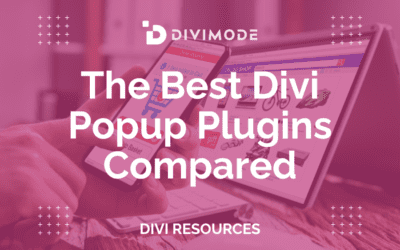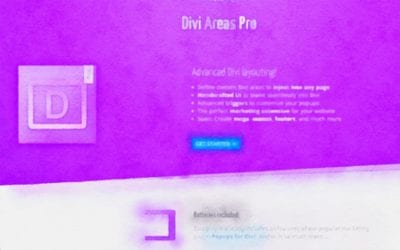Today, we’re going to talk about popups – sometimes users’ worst browsing nightmare and, often, the online marketing and sales tactic that most successful businesses swear by.
Websites that include popups consistently outperform websites that don’t include them, and popups also provide potential customers with more than one engaging point.
Of course, popups began just as another marketing fad that became overused throughout the years, but practices have evolved, and now, when used properly, popups can drive a far better conversion rate than any advertisement online.
But you can only use popups for Divi websites effectively if you are familiar with how users think regarding popups and the psychology tips behind the successful ones that drive sales.
Let’s delve into each of them.
Table of Contents
- FAQs About Using Psychology in Websites
- Common Popup Mistakes
- Common Popup Convictions
- Popup Psychology Tips that Drive Sales
- How Can DiviMode Help
- Wrapping Up
FAQs About Using Psychology in Websites
How can psychology be used to optimize websites for better conversion rates?
Psychology can be used to optimize websites for better conversion rates by understanding and applying principles that influence user behavior.
By leveraging psychological techniques, such as persuasive design, social proof, scarcity, and cognitive biases, you can create a website that resonates with users and increases the likelihood of conversions.
What is persuasive design and how does it impact conversions?
Persuasive design involves using design elements, copy, and visual cues to influence user behaviour and guide them toward desired actions.
By applying principles of persuasion, such as emphasizing benefits, using compelling calls-to-action, and creating a sense of urgency, persuasive design can significantly impact conversion rates by motivating users to take action.
How does social proof affect website conversions?
Social proof is a psychological concept that suggests people are influenced by the actions and opinions of others.
By showcasing testimonials, reviews, ratings, or social media shares, you can leverage social proof to build trust and credibility.
Positive social proof can enhance conversions by reassuring visitors that others have had a positive experience with your products or services.
What is the role of scarcity in optimizing website conversions?
Scarcity is a psychological principle that suggests people perceive limited availability as more valuable.
By creating a sense of scarcity through limited-time offers, exclusive deals, or showcasing limited stock, you can tap into people’s fear of missing out (FOMO) and drive conversions.
Scarcity can create a sense of urgency, motivating users to take action before the opportunity is gone.
How do cognitive biases impact website conversions?
Cognitive biases are inherent mental shortcuts that influence decision-making. By understanding and leveraging cognitive biases like the anchoring effect, loss aversion, or the decoy effect, you can shape the choices and perceptions of users on your website.
Cognitive biases can be utilized to nudge users towards desired actions, leading to improved conversion rates.
What are some psychological techniques for enhancing website conversions?
Some psychological techniques for enhancing website conversions include:
- Clear and compelling calls-to-action (CTAs) that prompt immediate action.
- Personalization and tailoring content to the specific needs and preferences of users.
- Creating a sense of urgency through limited-time offers or countdown timers.
- Offering social proof through testimonials, reviews, or case studies.
- Using storytelling to engage users emotionally and create a connection.
- Simplifying decision-making by providing fewer options or guiding users through a step-by-step process.
How can color psychology be applied to optimize website conversions?
Color psychology refers to the impact colors have on human emotions and behavior. By understanding the psychological associations of different colors, you can strategically use them in your website design and call-to-action buttons to evoke specific emotions or encourage desired actions.
For example, using warm colors like red or orange can convey urgency or excitement, while blue can evoke trust or calmness.
Should I use psychological techniques ethically when optimizing for conversions?
Yes, it is crucial to use psychological techniques ethically when optimizing for conversions.
Transparency, honesty, and user-centricity should always be prioritized. Avoid using manipulative tactics or misleading information that could harm the user experience or erode trust.
Strive for ethical optimization that respects users’ autonomy and provides genuine value.
How can A/B testing be utilized to optimize psychological elements for better conversions?
A/B testing is a valuable technique for optimizing psychological elements on your website.
By creating multiple versions of a page with different psychological elements, such as different colors, social proof placement, or wording in CTAs, you can compare their performance and determine which elements lead to better conversion rates.
A/B testing allows you to make data-driven decisions and continuously refine your website’s optimization strategies.
Can psychology be applied to all types of websites and industries?
Yes, psychology can be applied to all types of websites and industries. Understanding and leveraging psychological principles is valuable in influencing user behavior and improving conversion rates across diverse sectors.
However, it is important to consider the specific characteristics and preferences of your target audience and adapt psychological techniques accordingly.
Conduct research, gather user feedback, and analyze data to tailor psychological strategies to your specific industry and website context.
Common Popup Mistakes

As a company that builds plugins that can turn any Divi section into a popup, we understand popups.
However, we know that popups can often be intrusive, particularly the non-particular and pointless ones. Those are the types of popups that people hate interacting with, and no matter how good the popup plugin is, it’s not that powerful to change their failing outcome.
There are several mistakes that can be made with popups that can hurt your conversion rate:
Patronizing Language
Nobody wants to be commanded or disrespected, particularly when they want to purchase from your business. But we frequently see a condescending CTA in popups, particularly when someone wants to pressure a potential customer for quick action.
The point is, if people want to proceed towards clicking the call-to-action, subscribing to your newsletter, or buying your product, they don’t have to be pressured. By the time they click on the popup, they should be convinced already.
Large Number of Fields
Sometimes, you just want to gather more information about your potential customers, and of course, you want them to enter as much information as possible. While the intent is positive, the more questions and fields you include in the popup, the more annoyed people can get.
Long popups and form fields are what make website visitors bounce immediately, and you’ll lose conversion opportunities as a result. Only essential data is what counts for everyone.
Wrong Timing
When and where popups appear can make all the difference. Think about it – would you like for a popup to appear to you even if you haven’t seen the start of the page yet?
Bad timing is one of the reasons why most popups are considered intrusive and ultimately, the reason why many websites lose potential customers and page visitors. Whatever you’re promoting, a timely triggered popup will serve the entire UX better, not only conversion rates.
Whether you’ve committed at least one or all the popup mistakes above, in the following sections, we will continue with advice and practices on how to avoid creating low-converting popups and motivate potential customers to opt for the CTA no matter what your business is.
Not Prioritizing Experience
When implementing psychology-driven popups on your Divi website, it’s essential to prioritize the user experience. Popups can be highly effective for driving sales and conversions, but if not handled thoughtfully, they can also be intrusive and disrupt the visitor’s journey. Popups should feel like a natural extension of your site’s branding and design rather than appearing as disruptive elements.
Common Popup Convictions

Most people would say that they hate popups. Not everyone is a web designer or marketer, and not everyone understands the power that popups have for boosting ROI and offering exactly what a potential customer needs at the moment. In most cases, website visitors would say:
“Popups Interrupt Me”
Popups convert most of the page visitors when executed correctly. But, when visitors are forced to see a popup that doesn’t help them get the specific value that they’re after, popups do the opposite.
When potential customers look for something important on the page, an interruptive popup forces them to switch pages and decisions, which wasn’t their intent in the first place. This distracts them to the point of leaving your website, reducing the chances that they’ll ever come back.
Therefore, you need to make sure that your popups are timed according to the optimal time of page visit, specific page or post, and users’ exit-intent.
“Popups Ruin My Experience”
The fundamental purpose of popups is to interrupt briefly but, at the same time, improve the overall UX of the page.
User experience is more than just a straightforward and usable website. It is about meeting users’ goals, and the right popup always creates a positive experience for both the page visitor and website owner. This is why showcasing highly-targeted popups to your target users is important.
Popup Psychology Tips that Drive Sales
Now, if you have a Divi website and you want to boost your sales efforts, then you might consider a variety of techniques and advertising that you can integrate.
However, with popups, you can spend far less resources than advertising, and more importantly, you can use any sales or advertising psychology to improve your efforts.
The following are the most powerful psychology tips to increase sales via popups.
1. Become Intriguing
Being intriguing and slightly secretive can be extremely powerful, both in real life and in sales.
For example, if you read somewhere that something is “TOP SECRET”, you will become curious to see what’s that. After all, we’re just human beings, and we want to find out.
Moreover, this doesn’t have to be a ‘secret’ at all. Sometimes, you want to intrigue your potential customers to discover what’s best for them, and a popup at the right moment can come in handy.

This popup above does a great job of asking a great question that intrigues potential customers to learn more. This means that if people are on the product pages but haven’t decided what the best skincare product is, they can access the quiz and receive a personalized offer.
It is not just about making customers think what’s best for them, it’s also about guiding them to the right answer, resulting in higher sales and pleased customers in the process.
2. Leverage FOMO
FOMO, or fear of missing out, is the effect that makes people feeling a sense of anxiety that they’ll miss out on something that they should take before it runs out.
When we’re talking about popups, you can cause FOMO by offering a product sale, discount, limited-time offer, or an extremely valuable piece of content that is only available for a brief period of time or it can only be accessed through the popup.

The popup above motivates visitors to enter the Black Friday campaign with a great discount before it ends, driving more sales as a result.
To make this psychology technique work for your sales efforts, you need to make sure that what you present in the popup is compelling enough for visitors to grab their attention.
3. Offer Instant Incentive
If you want your popups to achieve an instant positive first impression on your customers, you need to make sure that you provide enough incentive for them to make a quick decision on the spot.
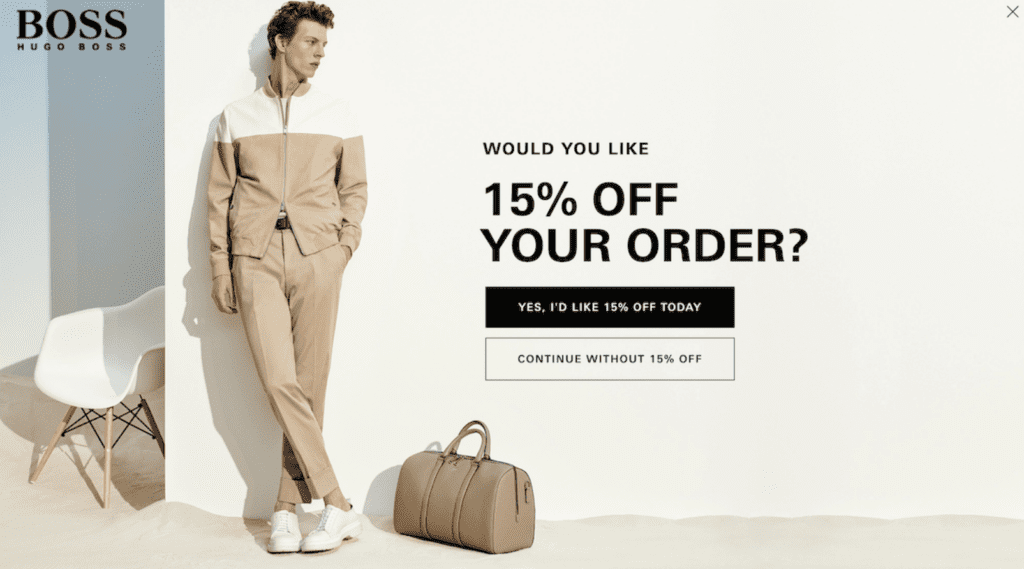
We all know that Hugo Boss can be expensive, so an immediate discount sounds like an excellent deal at any moment. Their full-screen overlay popup is an excellent move to incentivize their sales efforts, and it’s relevant to the target audience at hand.
When you know your audience well, a quick incentive is the best way to provide something of value that they can get immediately.
4. Showcase the Numbers
Business growth and sales are all about numbers and showcasing that your venture has grown to a different level is one of the best ways for potential customers to see value through your popups.
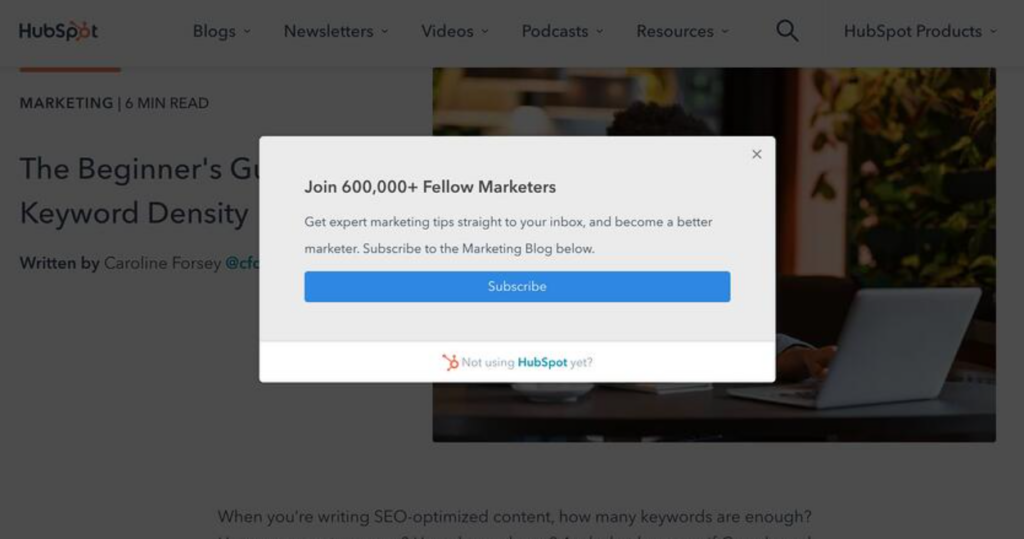
HubSpot’s exit-intent popup above showcases the right statistic that can retain and turn any visitor into a subscriber.
Besides inviting the visitor to join the 600,000+ blog subscribers, the popup also includes an additional link in the form of a question that leads the visitor directly to the product page.
This popup shows potential customers the progress that HubSpot have made throughout the years with their powerful content and newsletter and convinces them to become part of the community.
5. Play with Time
Lack of time is one of the most powerful psychological motivators! There’s nothing quite like it. The less time we have, the faster we must make a decision.
Thus, your potential customers will be more inclined to purchase immediately from your website when you place a limited time offer in front of them via popup.
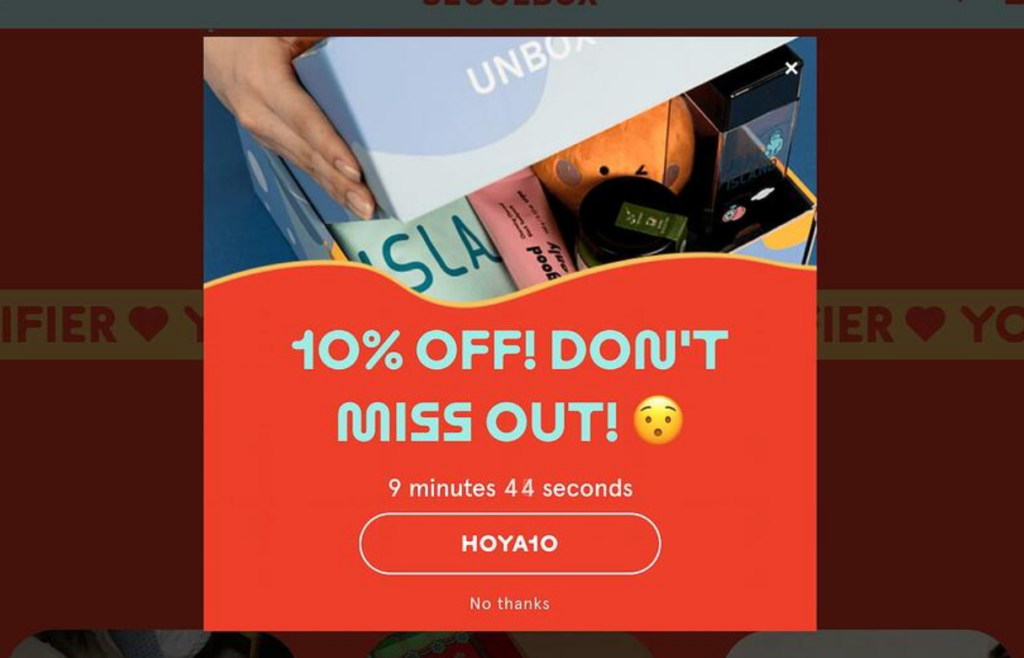
The discount lasts only for less than 10 minutes and counting down. This is when customers decide to purchase the products for a much affordable price than usual. With that in mind, you must play with time to ignite more sales and get more customers as a result.
6. Motivate & Persuade
In order for someone to purchase from your website, that person must be firstly motivated, and then persuaded to do so. Your customers can be extremely motivated if you convince them that they can achieve their goals with what you provide.
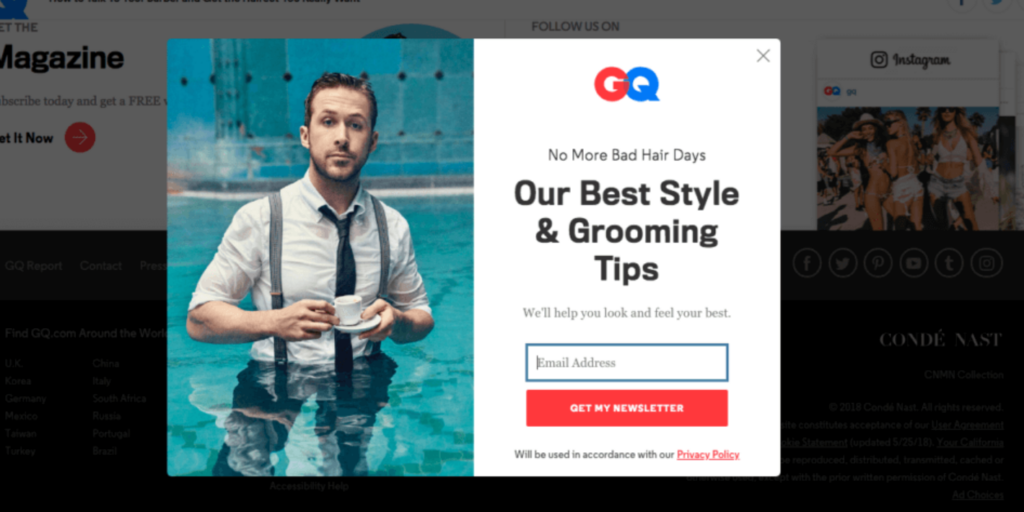
Take GQ as an example. They always have the right combination of popups, CTAs, and imagery that, added together, creates a motivational aspect for the potential subscriber.
7. Always Be Friendly
Everyone needs a friend, and to win more customers over, you need to be friendly and enthusiastic about every new customer.
When it comes to popup effectiveness, tapping into friendliness is more important than showing what your products can do. Being friendly motivates potential customers to interact with the popup and connect with your brand on an empathetic level.
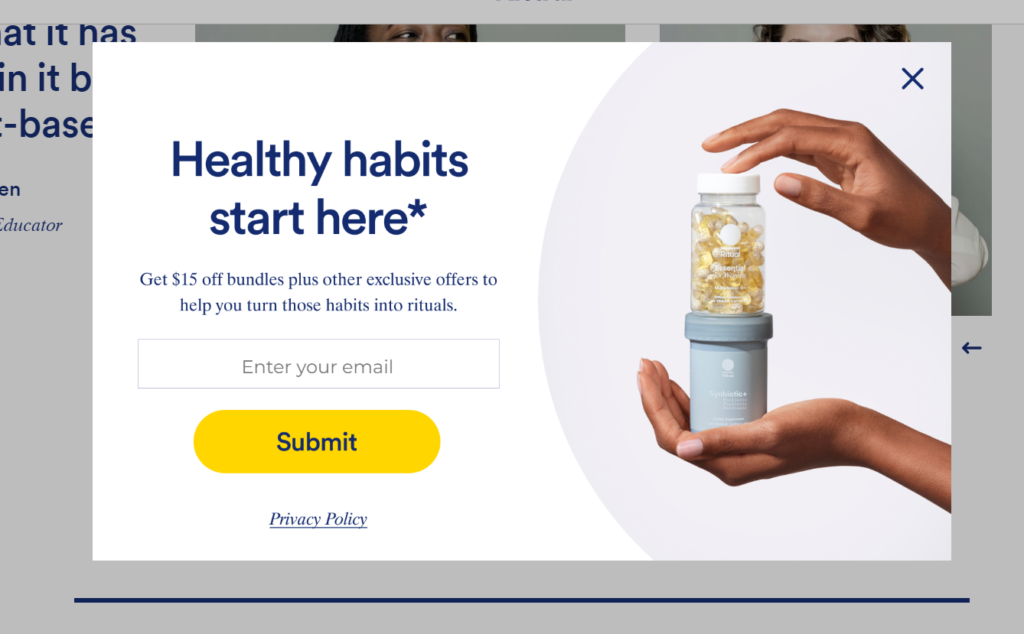
Ritual asks websites visitors that are about to enter with a friendly call-to-action that asks them to kick-start their healthy habits, with a discount.
They already know that whoever is on the site wants to start living healthier with better diet, and why not help them begin with a discount as well. After all, that’s what true friends are for, to help each other.
8. Create an Information Gap
Leaving potential customers to ask for more information themselves is one of the classic sales tactics to sell your product and the benefits that arrive with it.
Because, to sell a product, you want clients to know thoroughly what the product is about, and an information gap can motivate customers to click on your popup and ask for more.
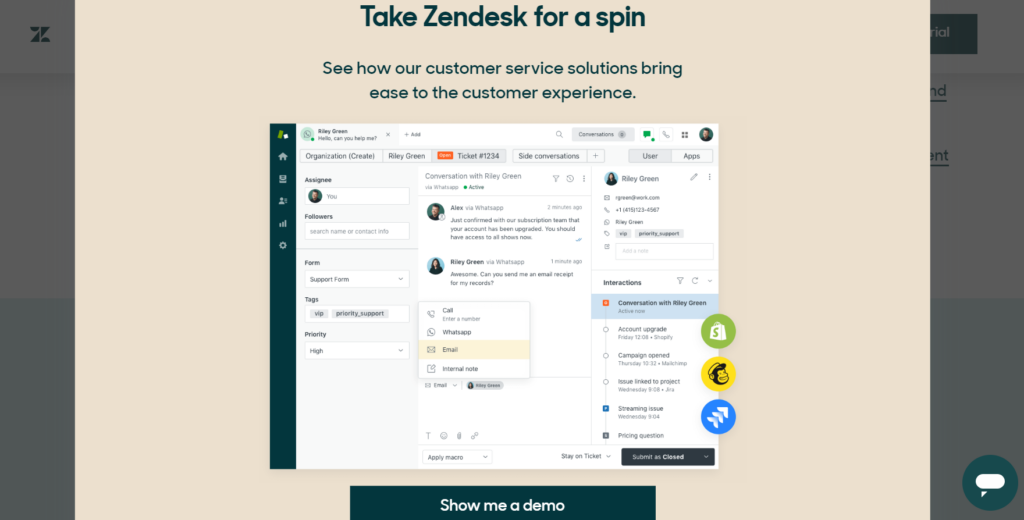
Zendesk’s straightforward invitation to users if they want to test Zendesk and learn how customers use the full version leads directly to a landing page where they can sign up and uncover the product completely.
So, if potential customers already know the benefits and features of your product, but they’re yet to test it, don’t hide everything from them. Instead, give them the option to get every information they need via popup.
If they want to, let them learn more about the experiences of using your product, something they wouldn’t necessarily learn by reading texts.
9. Activate the Lizard Brain
No, we’re not talking about an actual lizard brand. What lizard brain refers to is the part of your brain that triggers your primal instincts and our most primal emotions, such as fear.
However, we’re not saying that we want you to frighten your customers. Instead, you need to make them scared that they’ll miss out big time if they don’t opt for what you offer in the popup.
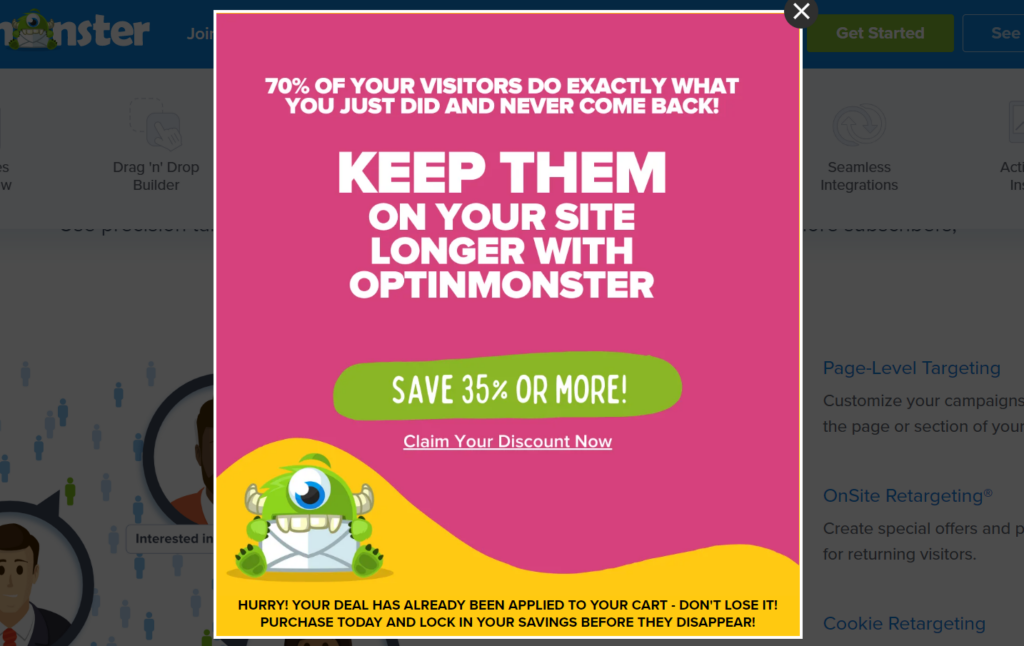
Optinmonster users the power of fear with factual statistics that more of your page visitors leave, and they don’t want you to do the same, both for them and for your website practices. Moreover, the discount that they offer amplifies this feeling even more.
Thus, this tactic works by motivating the potential customer on the cost of not opting for your offer.
How Can DiviMode Help
Let’s just say that we’re by no means psychology experts, and we’ve shared the advice above strictly based on our own observations and experiences in working with popups and conversion solutions for Divi websites.
However, as the founders of Popups for Divi – one of the most powerful popup plugins with 80,000+ installations on Divi websites, we also stand behind the ultimate solution for transforming every Divi section into a conversion-rate module or popup – Divi Areas Pro.
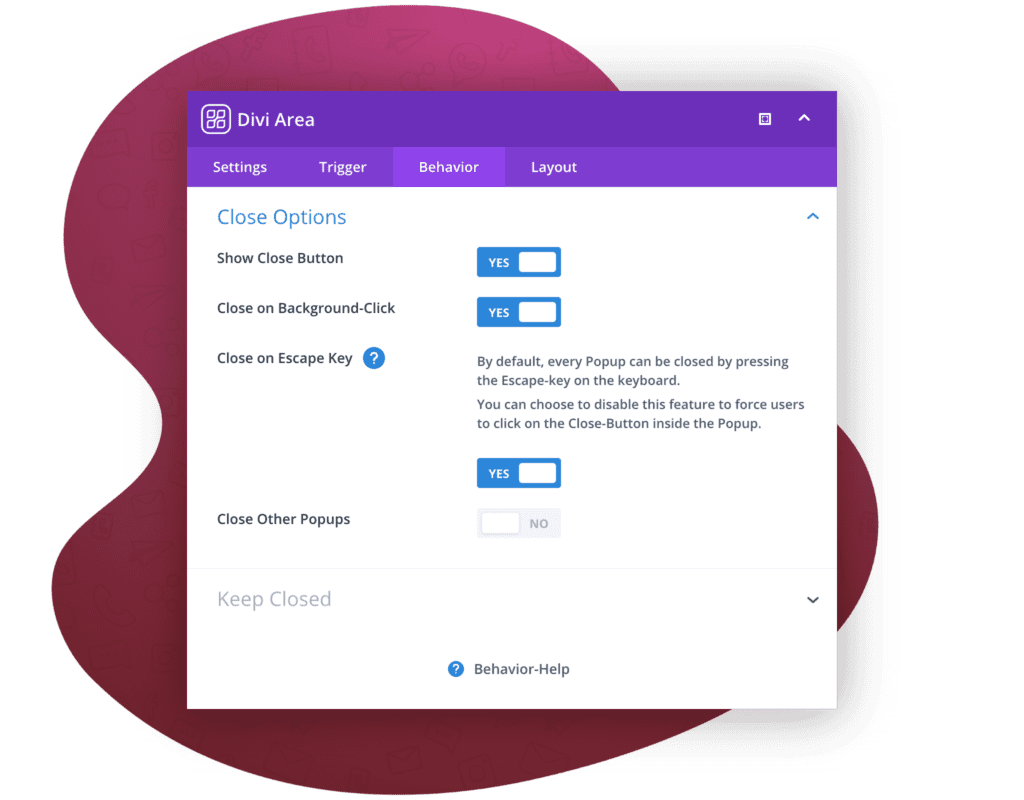
With Divi Areas Pro, you can build and customize campaigns with popups, fly-ins, hovers, mega menus, and conditional inline content, even if you’re a novice Divi user, creating truly interactive content as never before!
Moreover, you can fine-tune the trigger of every Area, whether you like to show it after a few seconds, when scrolling down, on exit intent, or when hovering a particular element or even create complete custom triggers in JavaScript.
For a further breakdown of Divi Area Pro’s features and pricing, we invite you to read our detailed blog post: Divi Areas Pro: Features Overview & Benefits.
Ready to join DiviMode and create the first popup for your email marketing campaign?
Get Started with DiviMode Today!
BONUS: Get a LIFETIME Access to Divi Areas Pro ($199 value) with 1-time payment and priority private support and live chat from our developers for maximum results – 14-day money-back guarantee! Click here to get started →
Wrapping Up
So, there you have it. 9 psychology tips to convert more page visitors into customers for your Divi website.
To recap, no matter your business and your target customers, you need to identify their habits and address their motivations into your popup marketing strategy, in order to drive more conversions and sales.
Address your customers’ personalities. Analyze their browsing and spending habits. And most importantly, no matter your strategy, observe how they react to your popup marketing.
Regardless of whether you’ve used or plan to use some of the tips above, each tactic must bring you closer to your business goals.

Try Divi Areas Pro today
Sounds interesting? Learn more about Divi Areas Pro and download your copy now!
Many pre-designed layouts. Automated triggers. No coding.
Click here for more details

